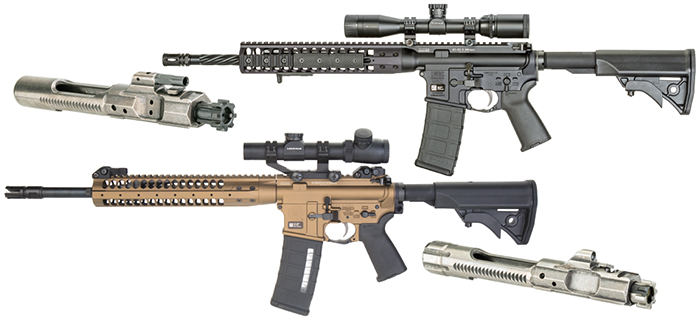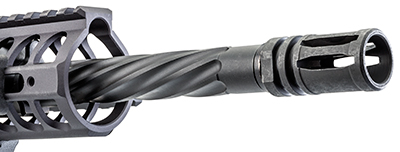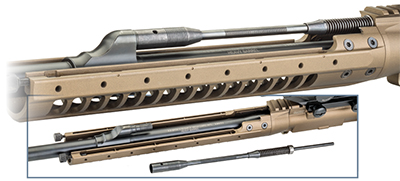
With its cold-hammer-forged and spiral-fluted barrel, the LWRCI IC-DI stands out from the crowd. There's more to it than that, though. The rifle, the company’s first direct-gas-impingement design, proved remarkably accurate. It was fitted with a Nikon M-223 2-8X 40 mm riflescope for evaluation.
As I pulled up to the nondescript, industrial brick and steel complex of buildings, it was obvious that this was a place that manufactured things. There were trucks and cars on the lot, not all new, but well-maintained, evidence of a skilled work force at its machines. But what was different was the number of NRA stickers. The facility could have made any number of things, but I knew that among them were firearms—really good ones.
The company I had come to see, LWRCI, is located on the Eastern Shore of Maryland, and before I take too many lumps, understand that I was born in the “Old Line State,” went to school there and lived in the now-incongruously named “Free State” for half my life. But the Eastern Shore and Western Maryland are like two different countries ruled through Annapolis by their more populous neighbors in Montgomery, Princes George's and Baltimore counties. But the water, watermen, good duck hunting and the schools closed on first day of deer season east of the Chesapeake Bay still remain. And there is manufacturing, and there are good manufacturing jobs. For that, you can thank in no small part Richard Bernstein, the retired founder of BAI Aerosystems, a maker of unmanned aerial vehicles. Despite anti-gun laws and anti-gun governors, Bernstein is committed to his people and keeping them at work, making parts.

Parts Is Parts? Not So Much
“We make parts,” Jason Miller, a senior design engineer for LWRCI, told me. “Really, really good parts,” he said with a self-effacing grin. Which is like saying Bulova is OK at making watch parts.
But that wasn’t always the case for the company, which started as an idea in 1998 as Leitner-Wise Rifle Co. It developed what was then thought to be the better mousetrap—a gas-piston system that overcame the perceived shortcomings of the direct-gas-impingement AR-15/M16 platform. Better mousetrap or no, the company had trouble making parts and delivering guns. Management quarreled, the founder left, the company changed its name to Land Warfare Resources Corp., and continued to struggle until 2008. That was when Bernstein, an Eastern Shore entrepreneur and businessman, became majority owner and moved it from Northern Virginia to Cambridge, Md. From about 10 employees, it has grown to around 160. And it was Bernstein who made the decision to put emphasis not just on military products—an area in which the company has had success worldwide—but also to offer its well-made semi-automatic rifles and carbines to civilian marksmen. And the acronym doesn’t stand for anything anymore, it’s just LWRCI. The “I” stands for International and denotes a prestigious contract the company landed with a major American ally in the Middle East for a version of its selective-fire carbine chambered in 6.8 mm SPC. While I was at the factory, I watched as pallets large and small were readied for shipment to friendly military and police forces around the world.
But it’s not like Bernstein and his very able manufacturing team were starting from scratch in a cornfield next to a chicken farm. Other companies owned and run by Bernstein and his son Kevin include MATECH and Xerion, which manufacture everything from fins for U.S. military mortar rounds to “military high-frequency filter dependent assemblies”—think military microwave technology.
And the company has a lot of machines in its 170,000- sq.-ft. facility on its 16-acre campus. Multi-axis CNC machines, a cold-hammer-forge, auto-feed CNC lathes, GFM screw machines, laser cutters, wire EDM machines, 3-D printers, you name it, odds are they have it. The company makes about 80 percent of its parts in-house—an almost unheard of number in the AR world—as most makers usually make a few key components, but are really more assemblers than manufacturers.

Too, LWRCI’s engineers can speak at length about anodizing, nitrides, nickel-boron, two-part bonds and adhesion properties. They all matter and are effective, though they are usually not cheap. LWRCI applies Type III anodizing, nickel-boron and NiCorr coatings. And the company does its own Cerakote in house. This is a company that spends a lot of its resources on research and development, regardless if it is for military wave emitters or rifles.
Not satisfied with the quality of available barrels, LWRCI bought its own cold-hammer forging machine—not a small investment. As a matter of fact, LWRCI is likely the only firearm company that has one yet is not already a household name in the gun business.

It’s not that Bernstein will just give the guys a blank check to buy machines. No, the philosophy of his facility, his engineers and his employees is, if they can make it better themselves, they are going to invest in the tooling to do it to their own standard of manufacturing excellence. You may be able to find a cheaper part, but odds are you can’t find one that is better-made. And, of course, guns are made out of, well, gun parts.
Piston Driven
So what makes an LWRCI an LWRCI? Forward of the receiver, LWRCI uses a barrel nut of its own design that allows its gas piston to pass through it at the 12 o’clock position and its own proprietary ARM-R rail system. If you look closely at the company’s logo you can see the silhouette of the recess for the piston at its top.

Turning out the two captive push screws on the front of the fore-end allows the top of the rail to be lifted off, exposing the short-stroke piston that is the heart of the company’s design. Gas is tapped through a port in the barrel into the gas block, where it goes into the gas nozzle. It then hits the piston cup, which fits over the nozzle. The latter is ribbed on its sides so the system is somewhat self-cleaning. The energy is transferred from the cup to an “intermediate rod” and from there to the operating rod, which travels through the barrel nut and spring support to hit the face of what would be the gas key on a direct-impingement rifle. On the LWRCI it is a flat surface that takes the impact of the piston and moves the bolt and bolt carrier. The piston’s spring is a flat-coil design that is forward of the barrel nut. The piston components are of Iconel alloy and can withstand the heat of continuous firing, up to 450 rounds of full-automatic, according to company sources. Its operation is not violent, and when you pull the bolt carrier out even after rapidly firing several magazines, it is merely warm to the touch. No excessive gas or heat enter the receiver—all of that takes place out front.
So Why 6.8 mm SPC?
The 6.8x43 mm Remington Special Purpose Cartridge was an idea that came from Special Forces soldiers of the 5th Special Forces Group—M/Sgt. Steve Holland prominently among them—that was designed by Remington in conjunction with the U.S. Army Marksmanship Unit and U.S. Special Operations Command. Intended to deliver improved terminal performance out of the M16/M4 platform, the 6.8 mm SPC doubled the bullet weight
(115 grs. vs. 62 grs.) over the conventional 5.56x45 mm NATO cartridge, improving both lethality and reach, while still utilizing the same lower receiver. Change out the upper and the magazine, and you have a much harder-hitting platform without a substantial weight penalty.
But the guys at LWRCI, including Miller, were not happy with magazine reliability using existing AR magazines with just a new follower. The magazine is the heart of any firearm; if it is not 100 percent reliable, the entire platform suffers.
So LWRCI worked with Magpul and asked for a larger magazine designed specifically around the 6.8 mm SPC, and it ended up slightly larger and wider than a standard AR magazine. That required a new lower receiver to accommodate it. Thus, the SIX8 family from LWRCI that includes the Special Purpose Rifle (SPR), the A2, the A5, the Ultra-Compact Individual Weapon (UCIW), the Razorback and the SIX8-Pistol, are all built on LWRCI’s proprietary short-stroke, gas-piston system. The guns are made in semi-automatic, selective-fire and are offered as short-barreled rifles as well.
I had the opportunity to shoot the 16"-barreled SIX8-SPR on my field trip to Cambridge, Md., where I made steel plates ring with almost monotonous regularity, I also interviewed Miller about the changes they had to make to the gun and magazine, and you can see it and other videos at americanrifleman.org/lwrci.
While the U.S. military has not made up its mind in terms of what it wants in a rifle cartridge, pig hunters love the 6.8 mm SPC—and for good reason. But that’s only half the story.
You Don’t Own That
While the 6.8 mm SPC piston-operated market was pretty much owned by LWRCI, the company actively sought to supply the next Individual Carbine or IC in 5.56x45 mm NATO for the U.S. Army’s Individual Carbine program, which was intended to replace the M4 or at least the upper receiver as part of an upper Product Improvement Program (PIP). The Army tested guns from quite a few manufacturers, but after two years the program was cancelled. While LWRCI didn’t win a big contract, it did develop an outstanding gas-piston design it calls the Individual Carbine or IC in 5.56x45 mm NATO or .300 Blackout.
Last spring, I had the opportunity to go to the range with the LWRCI guys, and they showed me a concept they had been working up for the PIP, a direct-impingement carbine with a new bolt carrier they invented. Not everyone is sold on piston operation, with Exhibit A being the M4/M16 issued to our troops today. Frankly, the U.S. military and most civilian shooters have not embraced the piston system. “Is it substantially better than a standard AR bolt?” I asked when they wanted to know what I thought. Miller looked at me like I really was not as intelligent as I purported to be, and replied, “Of course.” To which I answered, “Isn’t that what you guys do?” Six months later, the complete rifle was on my desk. Welcome to the IC-DI, the latter being for direct-impingement.
One of the hallmarks of LWRCI’s piston guns is the lack of a separate gas key—you don’t need one with a piston gun, but you do need a surface for the piston to impact to get the bolt and carrier moving. And misaligned gas keys on the AR/M16 can be a problem. On LWRCI’s IC-DI bolt, the gas key is machined integrally with the bolt, then a robust gas cup is pinned in place. The little geometry lessons LWRCI’s engineers have picked up making its guns—especially its selective-fire military and law-enforcement guns—have been incorporated into the design. The gas block, which is modeled on that for the firm’s piston guns and the gas tube are both NiCorr-coated.
The IC-DI’s barrel is also NiCorr-coated inside and out and has seven spiral flutes running the length of the 0.712"-diameter barrel measuring 0.20" across to reduce weight and give it a little more surface area for cooling, but really, as Miller told me, “It just looks cool.” Like other LWRCIs, it has five-groove polygonal rifling, but with a 1:7" RH twist and 11-degree crown.
The fore-end has the company’s Monoforge upper receiver with plenty of rail space for accessories, and it included a hand stop an angled fore-end grip with a sling point. I neglected to add that to the rifle shown here.
On the IC-DI, the grip is a Magpul MOE+, while the butt is a six-position model of the company’s own design with a QD slot. Controls are common to all LWRCIs and they include a bilateral two-position safety, bolt release and bolt lock. Too, the forged-then-machined charging handle is bilateral and of LWRCI’s own design. The trigger isn’t aftermarket but it might as well be—it broke at a crisp 7 lbs.
Range Time
I fired the SIX8 Razorback in 6.8 mm SPC and the IC-DI in 5.56x45 mm NATO, and the specifications and shooting results can be found nearby (LWRCI also offers the REPR line in 7.62x51 mm NATO that I did not test). On the Razorback, I mounted a Leupold Mark 4 1-5X 20 mm, while for the IC-DI, I mounted a Nikon M-223 2-8X 40 mm.
On the range, the benefits of the short-stroke piston made themselves apparent with the SIX8. There was no heat in the receiver area, nor was there the rush of gas past the face one gets with direct-impingement guns on ejection. All the heat and gas stay up front by the gas block and piston—something to watch for if you place your hand far forward on the fore-end as do many 3-gunners these days. I did not find the operation of the piston particularly violent, but believe the slight vertical stringing that occurred had to do with the greater heat and friction created by the 6.8 cartridge. And I was able to turn in several sub-minute-of-angle groups, with a respectable 1.61" average for five-shot groups at 100 yds.

As to the IC-DI, it was simply a delight to shoot. It is as nice an AR-style rifle as I have shot; quality parts and a rigid inspection process help make it top shelf. And it shot well, though it showed a definite preference for lighter weight bullets—especially Hornady’s .55-gr. TAP FPD—and a 55-gr. Norma load, although it did reasonable well with the 69-gr. Federal Gold Match. The sub-half-inch TAP group and many other tight groups came as the rifle was warm but not too hot to touch.

If you glance at the accompanying tables, these are not inexpensive rifles—even though the IC-DI is a step toward getting LWRCI guns into the hands of more shooters and hunters. But it is my hope that the reasons why LWRCIs cost what they do are understood in light of their manufacture. LWRCI builds its guns to its own standard of quality, and we know quality does not come cheap. Sometimes, you simply get what you pay for.








































